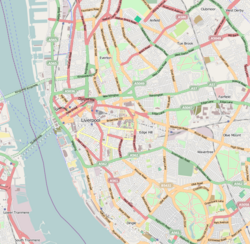
Yoko Ono is a Japanese multimedia artist, singer, songwriter, and peace activist. Her work also encompasses performance art and filmmaking.

Tate Liverpool is an art gallery and museum in Liverpool, Merseyside, England, and part of Tate, along with Tate St Ives, Cornwall, Tate Britain, London, and Tate Modern, London. The museum was an initiative of the Merseyside Development Corporation. Tate Liverpool was created to display work from the Tate Collection which comprises the national collection of British art from the year 1500 to the present day, and international modern art. The gallery also has a programme of temporary exhibitions. Until 2003, Tate Liverpool was the largest gallery of modern and contemporary art in the UK outside London.

The Science Museum is a major museum on Exhibition Road in South Kensington, London. It was founded in 1857 and is one of the city's major tourist attractions, attracting 3.3 million visitors annually in 2019.

The National Science and Media Museum, located in Bradford, West Yorkshire, is part of the national Science Museum Group in the UK. The museum has seven floors of galleries with permanent exhibitions focusing on photography, television, animation, videogaming, the Internet and the scientific principles behind light and colour. It also hosts temporary exhibitions and maintains a collection of 3.5 million pieces in its research facility.

The Science and Industry Museum in Manchester, England, traces the development of science, technology and industry with emphasis on the city's achievements in these fields. The museum is part of the Science Museum Group, a non-departmental public body of the Department for Digital, Culture, Media and Sport, having merged with the National Science Museum in 2012.
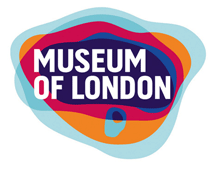
The Museum of London documents the history of the UK's capital city from prehistoric to modern times. It is located in the City of London on the London Wall, close to the Barbican Centre and is part of the Barbican complex of buildings created in the 1960s and 1970s to redevelop a bomb-damaged area of the city. The museum is the largest urban history collection in the world, with more than six million objects.

Imperial War Museum North is a museum in the Metropolitan Borough of Trafford in Greater Manchester, England. One of five branches of the Imperial War Museum, it explores the impact of modern conflicts on people and society. It is the first branch of the Imperial War Museum to be located in the north of England. The museum occupies a site overlooking the Manchester Ship Canal on Trafford Wharf Road, Trafford Park, an area which during the Second World War was a key industrial centre and consequently heavily bombed during the Manchester Blitz in 1940. Just across the Trafford Wharf Road from the Museum is the bulk of the Rank Hovis Flour Mill, a survivor from a former industrial age and now rather out of keeping with the surrounding architecture. The area is now home to the Lowry cultural centre and the MediaCityUK development, which stand opposite the museum at Salford Quays.

World Museum is a large museum in Liverpool, England which has extensive collections covering archaeology, ethnology and the natural and physical sciences. Special attractions include the Natural History Centre and a planetarium. Entry to the museum is free. The museum is part of National Museums Liverpool.

Pitt Rivers Museum is a museum displaying the archaeological and anthropological collections of the University of Oxford in England. The museum is located to the east of the Oxford University Museum of Natural History, and can only be accessed through that building.

The National Football Museum is England's national museum of football. It is based in the Urbis building in Manchester city centre, and preserves, conserves and displays important collections of football memorabilia.
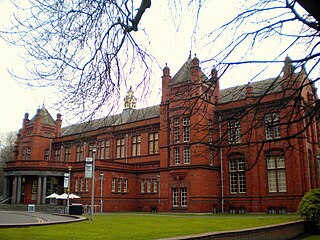
The Whitworth is an art gallery in Manchester, England, containing about 55,000 items in its collection. The gallery is located in Whitworth Park and is part of the University of Manchester.
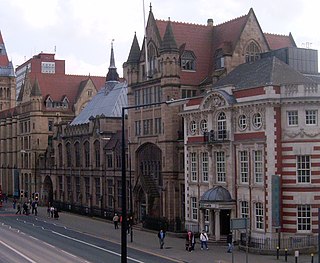
Manchester Museum is a museum displaying works of archaeology, anthropology and natural history and is owned by the University of Manchester, in England. Sited on Oxford Road (A34) at the heart of the university's group of neo-Gothic buildings, it provides access to about 4.5 million items from every continent. It is the UK's largest university museum and serves both as a major visitor attraction and as a resource for academic research and teaching. It has around 430,000 visitors each year.

Built in 1716–17 as a charity school, Bluecoat Chambers in School Lane is the oldest surviving building in central Liverpool, England. Following the Liverpool Blue Coat School's move to another site in 1906, the building was rented from 1907 onwards by the Sandon Studios Society. Based on the presence of this art society and the subsequent formation of the Bluecoat Society of Arts in 1927, the successor organisation laid claim to being the oldest arts centre in Great Britain, now called the Bluecoat.

The Museum of London Docklands, based in West India Quay, explains the history of the River Thames, the growth of Port of London and the docks historical link to the Atlantic slave trade. The museum is part of the Museum of London and is jointly funded by the City of London Corporation and the Greater London Authority.

The International Slavery Museum is a museum located in Liverpool, England that focuses on the history and legacy of the transatlantic slave trade. The museum which forms part of the Merseyside Maritime Museum, consists of three main galleries which focus on the lives of people in West Africa, their eventual enslavement, and their continued fight for freedom. Additionally the museum discusses slavery in the modern day as well as topics on racism and discrimination.
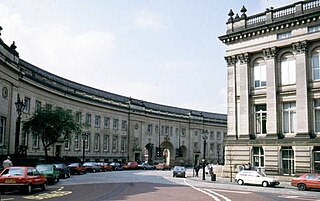
Bolton Museum is a public museum and art gallery in the town of Bolton, Greater Manchester, United Kingdom, owned by Bolton Metropolitan Borough Council. The museum is housed within the grade II listed Le Mans Crescent near Bolton Town Hall and shares its main entrance with the central library in a purpose-built civic centre. The building has good accessibility.

Whitstable Museum is a heritage centre in Whitstable, Kent, with Invicta, one of the world's oldest steam engines, the history of the local oyster trade and historical diving equipment.
The culture of Liverpool incorporates a wide range of activities within the city of Liverpool, England. The city is an important centre for culture not just in the northwest of England, but also the United Kingdom more broadly. Its contributions to culture internationally were recognised in 2008, when it was named the European Capital of Culture.
Harry Goodwin was a British photographer, known for his images of pop musicians and sports personalities. He was the resident photographer of the BBC Television programme Top of the Pops from its inception in 1964 until 1973.
The Liverpool 08 Collection was the Public art collection exhibited by Liverpool John Lennon Airport in conjunction with the Liverpool Culture Company for the duration of 2008, the year when Liverpool was the European Capital of Culture. Exhibits were launched before and during the year by various celebrities including Yoko Ono and Phil Redmond and much of the exhibition remains in place today. As well as the iconic sculptures, The Yellow Submarine (sculpture) and the John Lennon Statue, the different pieces of artwork situated around the public areas of the terminal included; two rare suits worn by John Lennon, photographs by Harry Goodwin and Paul Saltzman, mosaics from Debbie Ryan, graphic designs by John McFaul, a film by Nick Jordan, a performance of Brian Eno's 'Music for Airports' and artwork from 50 schoolchildren at St Ambrose Primary School in Speke

